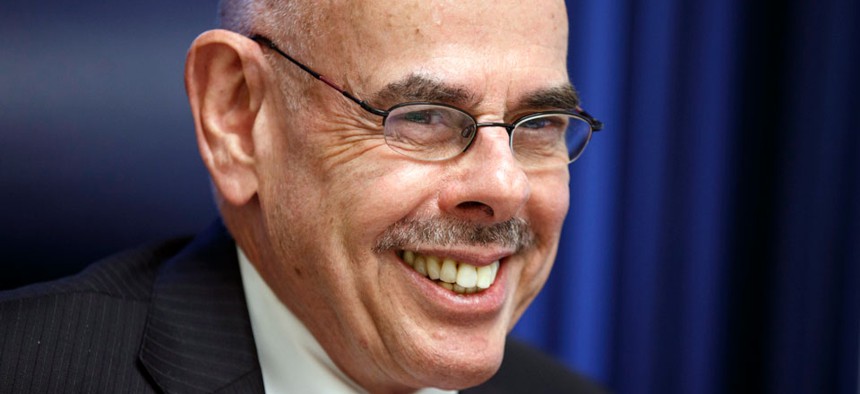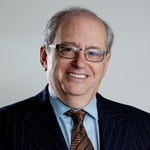
Rep. Henry Waxman, D-Calif. AP
Analysis: Henry Waxman: A Relic of the Era When Congress Used to Work
With the possible exceptions of Ted Kennedy and John Dingell, no one in the past 50 years or more has had a broader impact on American society than the retiring California representative.
I was introduced to Congress in 1965 by a newly minted professor at the University of Minnesota, Gene Eidenberg, who had come to the state fresh from a stint as an American Political Science Association congressional fellow working for the late Hale Boggs, the majority whip. Eidenberg sat across from D.B. Hardeman, a legendary figure who had earlier been the top assistant to Speaker Sam Rayburn. In his class on Congress, a charismatic and dynamic Eidenberg mesmerized me with his stories of life in Congress, of the larger-than-life figures he worked with and encountered, of the sheer magic and messiness of lawmaking.
That class began my lifelong love affair with the institution—which, as regular readers know, has included plenty of periods of tough love, indignation, and outrage at the betrayal of regular order or fundamental principles. Inspired by Eidenberg, I followed in his footsteps with my own congressional fellowship in 1969-70. There I worked for Representative Donald M. Fraser, with a desk inside his own personal office, and I watched, mesmerized again, as he showed what a committed, smart, and gutsy legislator could do. Fraser, despite a junior status in a body then wholly dominated by the senior system, found ways to make things happen. He fought the Greek military junta and injected human rights into American foreign policy at a time when it was at best an afterthought; pioneered a set of party and congressional reforms that ultimately transformed the presidential nominating process and the seniority system; created the District of Columbia’s Advisory Neighborhood Commissions, an important innovation in local governance; and on and on.
From Fraser I developed a deep appreciation for the craft of the legislator. Some of the good ones used their available bully pulpits, however puny, to frame and influence agendas; some used their mastery of the rules and procedures to achieve policy ends; some built immense expertise in important, if arcane, policy areas and used that expertise to craft good legislation that made a real difference in the world. Fraser’s friend Bob Kastenmeier, for example, focused for three decades on trademarks, patents, and intellectual property, not subjects that would bring wide acclaim, but which in today’s global economy are critical to American prosperity—and the country is much better off because of his efforts.
Paul Sarbanes built a reputation in the House, and then the Senate, as the consummate legislative craftsman, who cared more about the details of bills than who got the credit for them.
I watched with admiration when liberals Ted Kennedy and George Miller, who recently announced his retirement from the House, worked with conservative John Boehner to craft the No Child Left Behind Act in 2001—it was a pleasure to watch real legislators craft real legislation. I remain a huge admirer of Alan Simpson and John McCain. True, both have said and done things that have made me cringe. But nobody cares more about making this country and its Congress work than Alan Simpson. To watch him team with House Democrat Ron Mazzoli to pull together an earlier generation of immigration reforms was to watch a master at work. As for McCain, when I told him in the 1990s that I thought his first-generation McCain-Feingold campaign-finance reform was unworkable, despite the kudos it got from editorial pages, he made it clear that he did not want an issue but a bill that could both pass and work. And he did everything one could ask to make that happen, and to get it enacted. Good legislators are first and foremost problem solvers, and that fits both of these guys.
It is a truism now that Congress and the American political system are gripped in sharp partisan and ideological polarization. But polarization does not lead inexorably to stalemate or gridlock.
By any reasonable standard, Simpson and McCain are strong conservatives, just as by any standard Ted Kennedy was a strong liberal. Their intense views and strongly held principles did not keep them from working tirelessly to find solutions to vexing national problems, through a combination of compromise and the search for common ground. Simpson did it with Mazzoli; McCain did it with Feingold (and other liberals on climate change and immigration); Kennedy did it with Orrin Hatch, Strom Thurmond, and countless other strong conservatives. John Dingell, another strong liberal (on most issues,) found common ground with conservative Republicans on voting rights, clean water, health care, and many others.
And that brings me to Henry Waxman. It is a little difficult for me to write about Waxman. He and his family have been friends with me and my family for more than 30 years. I view him in part through a different lens—that of Henry the person who is a gentle, warm, kind, religious family man with a wonderful wife and kids, a consummate mensch. But I can also step outside that setting to analyze Waxman’s 40-year career in the House. Here is the bottom line: With the possible exceptions of Ted Kennedy and John Dingell, no one in the past 50 years or more has had a broader impact on American society than Waxman.
It should come as no surprise that Waxman’s retirement announcement brought glee from House Republicans. His worldview is not theirs; the common ground he found with Republicans over decades on many issues is gone now, with a Republican Conference tilted so far to the right. It was a touch amusing to see The Washington Post refer last week to Idaho Republican Mike Simpson as a “centrist.” By the standards of a few years ago, or by any reasonable standards, Simpson is a staunch conservative.
Just as Waxman by any standard is a staunch and passionate liberal. But Waxman’s incredible success as a legislator was built on finding Republican partners, or at least Republican allies, to advance his goals of alleviating poverty, cleaning up the air and water, fighting the health scourge of tobacco, reducing carbon emissions, and expanding health insurance and healthcare. Henry has done it with legislation crafted in the Energy Commerce Committee, in tough negotiations in conference committees, via hearings in the Government Operations or Oversight and Government Reform Committee. Jonathan Cohn of The New Republic listed Waxman’s legislative accomplishments, and they are staggering in number and breadth.
What most impressed me about his record as a legislator was not what he accomplished alongside a Democratic president (although I have not seen a more impressive effort than the one Waxman and Edward Markey showed in passing cap and trade in the House). It was what he was able to do when Ronald Reagan was in the saddle and when cutting government social programs was ascendant and seemingly inexorable. Little by little, bit by bit, Waxman expanded Medicaid to children and poor pregnant women, and found other ways to shape and strengthen the social safety net. Through a combination of political savvy, unmatched knowledge of the programs and their details, incredible patience, and great negotiating skills, Waxman got half a loaf here, a quarter loaf there. And by the end of the Reagan Administration, we had a much bigger safety-net loaf than had existed before 1980.
A few years back, I wrote a column about Dingell, Markey, and Waxman, three master lawmakers on the House Commerce Committee, and how each was characterized by incredibly smart, strong, and savvy staffs, with top people so loyal they would keep coming back to work for their longtime bosses, despite having often taken major-league pay cuts. Nobody has had better, smarter, and more loyal staffers than Waxman, another key to his great success.
That staff depth and expertise were instrumental in Waxman’s success in investigations and oversight. He made sure he and his staff did their homework before having hearings or calling witnesses, and they rarely if ever jumped the gun or leaked slanted information to prejudge or prejudice a case. Where he could, he worked with Republicans. I got many calls from reporters when Waxman and Republican Tom Davis held a ballyhooed hearing on drug use in sports, the hearing that showcased, and impeached, Roger Clemens. “What business is this of Congress? Isn’t this just showboating?” were typical questions. I said I thought it was very much in Congress’s purview: Sports are huge economic machines, generating billions in revenue and serving as role models for many millions of young Americans. As we look at the dynamic now, with the damage that performance-enhancing drugs have done to sports and the actions taken by leagues to combat the problem, it is clear that the bipartisan hearing, with the groundwork laid by the staff, made a big and positive difference.
Waxman at 74 is young and healthy enough to write another chapter in his career (and, I hope and expect, to spend more time with his family and friends). But alongside his incredible policy achievements, he leaves a template for how a lawmaker can and should operate. You don’t have to be a centrist to make things happen in Congress. You do have to respect your own institution; understand how to build coalitions; rely on honest facts and figures and top-quality expertise; transcend tribal differences; and recognize that much that is worthwhile will require years of effort. There are reasons why those axioms won’t work in today’s deeply dysfunctional Congress. But there is no good reason why they shouldn’t.
NEXT STORY: Play of the Day: Obamacare Puts America to Sleep







